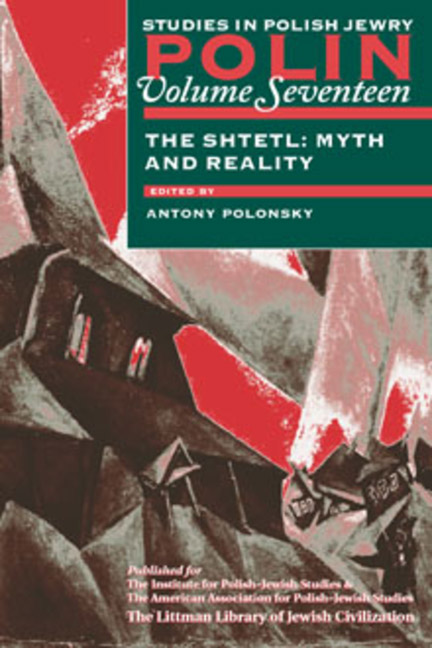Book contents
- Frontmatter
- Dedication
- Editors and Advisers
- Preface
- Polin
- Polin: Studies inPolish Jewry
- Contents
- Note on Place Names
- Note on Transliteration
- List of Abbreviations
- PART I THE SHTETL: MYTH AND REALITY
- PART II NEW VIEWS
- PART III DOCUMENTS
- PART IV THE SIXTY-FIFTH ANNIVERSARY OF EVENTS IN PRZYTYK: A DEBATE
- If Not a Pogrom, Then What?
- Pogrom? The Polish–Jewish Incidents in Przytyk, 9 March 1936
- It Was No Ordinary Fight
- Life and History
- Letter from Ryszard Fenigsen
- Przytyk and the Market Stall
- PART V REVIEWS
- OBITUARIES
- Notes on the Contributors
- Glossary
- Index
Letter from Ryszard Fenigsen
from PART IV - THE SIXTY-FIFTH ANNIVERSARY OF EVENTS IN PRZYTYK: A DEBATE
- Frontmatter
- Dedication
- Editors and Advisers
- Preface
- Polin
- Polin: Studies inPolish Jewry
- Contents
- Note on Place Names
- Note on Transliteration
- List of Abbreviations
- PART I THE SHTETL: MYTH AND REALITY
- PART II NEW VIEWS
- PART III DOCUMENTS
- PART IV THE SIXTY-FIFTH ANNIVERSARY OF EVENTS IN PRZYTYK: A DEBATE
- If Not a Pogrom, Then What?
- Pogrom? The Polish–Jewish Incidents in Przytyk, 9 March 1936
- It Was No Ordinary Fight
- Life and History
- Letter from Ryszard Fenigsen
- Przytyk and the Market Stall
- PART V REVIEWS
- OBITUARIES
- Notes on the Contributors
- Glossary
- Index
Summary
Dear Sir:
I should like to add my voice to the discussion surrounding the 65th anniversary of the events in Przytyk (Gazeta Wyborcza, 27 March 2001).
Three weeks after the pogrom, in the bright light of day, at one o'clock in the afternoon, the Przytyk marketplace made a strange impression. Silence reigned. Grass had sprung up between the paving stones. The shops were closed. No one was there. A few people still lay in hospital in Radom, and the rest did not show themselves.
I was there because my father, the lawyer Ludwik Fenigsen, had come from Warsaw with his colleague Szumański during the preparation period for the trial concerning the incidents in Przytyk to see where the events had taken place, and they brought me with them.
During the June 1936 trial my father made a civil claim for a symbolic zloty before the District Court in Radom on behalf of the orphans of the murder victims Josek and Chaja Minkowski. The Minkowski children had also been beaten with a heavy stone and a bar; Gawryś suffered a broken parietal bone and a broken rib, and 6-year-old Szmulek was pulled out from under the bed and beaten about the head. The attackers did not find the two smaller children.
The drama of Przytyk lasted only an hour and played out in the marketplace, on Warszawska Street, on the bridge across the Radomka, and in the suburbs of Zache˛ta and Podgajek. Two thousand people ran through the streets, and a few dozen or perhaps a hundred-odd people among them were the ones who, at the command of the fighting squad of the Endecja (National Democratic Party), broke windows, forced open doors, demolished homes, and beat people with heavy objects. Several others shot into the crowd. The small police detachment did everything, it seems, to restrain the mayhem and defend the lives of the citizens. From witness testimony and police reports, snapshot images emerge: 70-year-old Jochweta Palant runs out into the street to look for her children; the crowd surrounds her and beats her with sticks, leaving a dent in her skull. Fajga Szuch goes out to meet the attackers in order to draw their attention away from the eight children she has hidden in her attic; she is beaten, sustaining injuries to her head and spine.
- Type
- Chapter
- Information
- The Shtetl: Myth and Reality , pp. 401 - 403Publisher: Liverpool University PressPrint publication year: 2004



